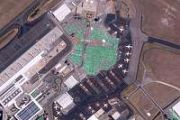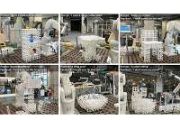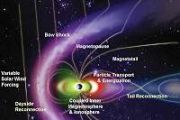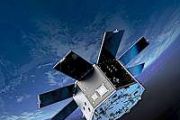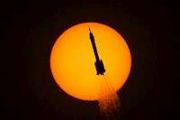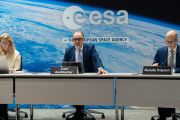
Copernical Team
SATMAR nanosatellite to debut in June advancing digital maritime connectivity
 The maritime industry's digital evolution will gain momentum on June 21 with the scheduled launch of SATMAR, a 6U nanosatellite engineered entirely by Alen Space. The satellite will lift off aboard a SpaceX Falcon 9 rocket during the Transporter-14 rideshare mission from Vandenberg Space Force Base in California.
Developed in collaboration with Egatel and backed by Spain's Ports 4.0 innova
The maritime industry's digital evolution will gain momentum on June 21 with the scheduled launch of SATMAR, a 6U nanosatellite engineered entirely by Alen Space. The satellite will lift off aboard a SpaceX Falcon 9 rocket during the Transporter-14 rideshare mission from Vandenberg Space Force Base in California.
Developed in collaboration with Egatel and backed by Spain's Ports 4.0 innova Intelsat Secures Indian Approval to Expand Satellite Broadcast Services
 Intelsat has received official authorization from the Indian government to deliver satellite broadcast services directly to India's media sector, becoming one of the first foreign operators to gain such access. This regulatory green light allows Intelsat to accelerate its strategic expansion into the Indian market and deepen its investment in the region.
The approval covers four of Intelsa
Intelsat has received official authorization from the Indian government to deliver satellite broadcast services directly to India's media sector, becoming one of the first foreign operators to gain such access. This regulatory green light allows Intelsat to accelerate its strategic expansion into the Indian market and deepen its investment in the region.
The approval covers four of Intelsa GoBIC intersatellite service reaches operational maturity with TRL9 milestone
 IQ spacecom has announced that its Go.BIC service has attained Technology Readiness Level 9, marking full operational status following comprehensive in-orbit testing. This achievement positions Go.BIC-the first dynamic global on-demand bidirectional intersatellite connection service-as a mature and deployable solution for Low Earth Orbit (LEO) communications.
Go.BIC was launched in collabo
IQ spacecom has announced that its Go.BIC service has attained Technology Readiness Level 9, marking full operational status following comprehensive in-orbit testing. This achievement positions Go.BIC-the first dynamic global on-demand bidirectional intersatellite connection service-as a mature and deployable solution for Low Earth Orbit (LEO) communications.
Go.BIC was launched in collabo EnduroSat secures 43 million euro boost to expand Gen3 satellite manufacturing
 EnduroSat has announced a euro 43 million investment round led by Founders Fund, with CEECAT Capital, Morphosis Capital, and other previous backers participating. The funding will enable the company to accelerate the production of its Gen3 ESPA-class satellites, which weigh between 200 and 500 kilograms and feature advanced avionics and a modular, software-defined design.
These next-gener
EnduroSat has announced a euro 43 million investment round led by Founders Fund, with CEECAT Capital, Morphosis Capital, and other previous backers participating. The funding will enable the company to accelerate the production of its Gen3 ESPA-class satellites, which weigh between 200 and 500 kilograms and feature advanced avionics and a modular, software-defined design.
These next-gener After 50 successful years, the European Space Agency has some big challenges ahead
 This year marks the 50th anniversary of the founding of the European Space Agency (Esa). It has launched spectacularly successful missions, but is different to other space agencies which generally represent one country. Esa is funded by 23 member states and also has cooperation agreements with nations such as Canada.
Esa operates cutting edge spacecraft designed to monitor the Earth, as we
This year marks the 50th anniversary of the founding of the European Space Agency (Esa). It has launched spectacularly successful missions, but is different to other space agencies which generally represent one country. Esa is funded by 23 member states and also has cooperation agreements with nations such as Canada.
Esa operates cutting edge spacecraft designed to monitor the Earth, as we Solar atmosphere seen in sharpest detail yet thanks to new adaptive optics
 A breakthrough in solar imaging technology is offering scientists their clearest view yet of the Sun's corona, the ultra-hot outer layer of the solar atmosphere. Researchers at the U.S. National Science Foundation's National Solar Observatory (NSO) and the New Jersey Institute of Technology (NJIT) have successfully applied adaptive optics-typically used for imaging the Sun's surface-to the coron
A breakthrough in solar imaging technology is offering scientists their clearest view yet of the Sun's corona, the ultra-hot outer layer of the solar atmosphere. Researchers at the U.S. National Science Foundation's National Solar Observatory (NSO) and the New Jersey Institute of Technology (NJIT) have successfully applied adaptive optics-typically used for imaging the Sun's surface-to the coron Redwire delivers flight computer for ESAs Comet Interceptor mission targeting primordial comet
 Redwire Corporation (NYSE: RDW) has delivered the onboard computer for the European Space Agency's Comet Interceptor mission, marking a significant milestone in the development of the pioneering spacecraft. The system, produced by Redwire's Belgian subsidiary Redwire Space NV, will act as the central processing unit for the mission, managing spacecraft systems and relaying essential data to Eart
Redwire Corporation (NYSE: RDW) has delivered the onboard computer for the European Space Agency's Comet Interceptor mission, marking a significant milestone in the development of the pioneering spacecraft. The system, produced by Redwire's Belgian subsidiary Redwire Space NV, will act as the central processing unit for the mission, managing spacecraft systems and relaying essential data to Eart Rocket Lab to Acquire Geost in Strategic Expansion into Satellite Payloads
 Rocket Lab Corporation (Nasdaq: RKLB) has entered into a definitive agreement to acquire the parent company of Geost, LLC, a specialist in electro-optical and infrared (EO/IR) payloads for national security missions. The $275 million deal includes $125 million in cash and $150 million in Rocket Lab stock, with an additional $50 million possible through performance-based earnouts. The acquisition
Rocket Lab Corporation (Nasdaq: RKLB) has entered into a definitive agreement to acquire the parent company of Geost, LLC, a specialist in electro-optical and infrared (EO/IR) payloads for national security missions. The $275 million deal includes $125 million in cash and $150 million in Rocket Lab stock, with an additional $50 million possible through performance-based earnouts. The acquisition From Rice to orbit: Student engineers build safer, low-cost satellite thruster
 By the end of the decade, the global small satellite industry is projected to nearly double. Small satellites are critical for faster, better and more secure communications and internet solutions as well as environmental sensing, weather monitoring and national security.
A team of Rice University engineering students has designed and built a safer, low-cost propulsion module for small sate
By the end of the decade, the global small satellite industry is projected to nearly double. Small satellites are critical for faster, better and more secure communications and internet solutions as well as environmental sensing, weather monitoring and national security.
A team of Rice University engineering students has designed and built a safer, low-cost propulsion module for small sate Camouflage strategy developed for stealth and thermal control of satellites in infrared spectrum
 In response to the sharp rise in satellite deployments-now exceeding 9,850 globally-scientists are racing to protect these valuable assets from ground-based detection, particularly in the infrared spectrum. While visible and microwave detection have constraints, infrared sensors exploit low background radiation, making satellites highly vulnerable.
Addressing this issue, researchers led by
In response to the sharp rise in satellite deployments-now exceeding 9,850 globally-scientists are racing to protect these valuable assets from ground-based detection, particularly in the infrared spectrum. While visible and microwave detection have constraints, infrared sensors exploit low background radiation, making satellites highly vulnerable.
Addressing this issue, researchers led by 














